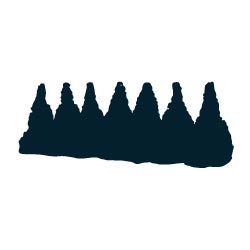Ursula von Rydingsvard For Adolescents

Untitled (Seven Mountains)
Ursula von Rydingsvard
Subject: Repetition of forms
Activity: Make a sculpture from small wood pieces
Materials: Small, similarly sized pieces of wood and glue
Vocabulary: expressive, graphite, organic, postminimalist
Daughter of a Ukrainian peasant woodcutter who fled to Germany in 1938, Ursula von Rydingsvard spent the first eight years of her life in refugee camps until the family came to the United States in 1950. She studied painting at the University of Miami and at the University of California, Berkeley. When she moved to New York in 1973, she turned to sculpture. Von Rydingsvard became one of the new generation of sculptors loosely labeled “postminimalist” because she used organic, natural forms to create expressive sculptures.
Von Rydingsvard constructs her sculptures from ordinary four-by-four-inch beams. She glues and dowels together layers of these beams into a massive three-dimensional grid of identically sized elements. She then chisels into the wood, leaving the surfaces craggy. Since 1986, von Rydingsvard has rubbed powdered graphite onto the surfaces of her sculptures. The dark gray graphite on reddish brown cedar produces a subtle surface coloration.
Why do you think von Rydingsvard coats her sculptures with graphite? Why not just let them stay their natural color?
What forms from nature come to mind when you look at the sculpture?
Von Rydingsvard greatly admires the pyramidal/ziggurat remains of the Maya temples in the Yucatan area of Mexico. Why do you think this is so? How do you think these structures influence her art?
Sometimes we can best understand a material’s impact by imagining a sculpture created in a different material. For instance, what if Untitled were made of reddish clay? Steel? Stone? Bronze? How would the sculpture change?
Why do you think the sculpture is subtitled Seven Mountains?
Using identically sized pieces of wood, construct your own sculpture. You might make a drawing or two on graph paper to plan out your sculpture. When you are done with the sculpture, think of ways that you might change the surface look.
Prior to 1986, von Rydingsvard rarely titled her sculptures; but since then she has preferred evocative, if sometimes baf ing, names (for example, Grzebyk, Ignatz Comes Home, Zakopane, Oj Dana Oj Dana, and Dreadfully Sorry).
Von Rydingsvard, Raoul Hague, and Hans Hokanson all used wood for their sculptures. Think about how they used wood similarly or differently. How did they cut it? How do the surfaces compare? What, if any, natural forms were they possibly inspired by?
Expressive - effectively conveying meaning or feeling
Graphite - a soft black form of carbon used for lead pencils
Organic - related to living organisms
Postminimalist - a term used for artistic work that is influenced by, or attempts to develop and go beyond, the aesthetic of minimalism (where work is stripped down to its most fundamental features)
